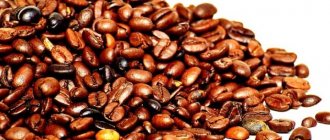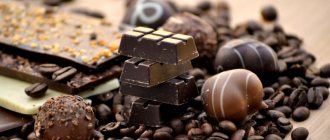What is theobromine
It is a purine alkaloid. Contained in amounts up to 1.5% in cocoa beans, less in cola nuts and in some types of plants of the holly family.
Theobromine in Latin is Theobromin. The name of the substance comes from the name of the cocoa tree (Theobrōma cacāo). Synonyms: dimethylxanthine xantheosis, diurobromine.
Theobromine formula is C7H8N4O2. According to its chemical structure, it is 3,7-dimethylxanthine.
The substance was first isolated in its pure form in 1841 from cocoa beans. Theobromine was obtained synthetically from xanthine in 1882. Currently, it is extracted for medicinal and food purposes from cocoa beans or waste from the dust of chocolate factories is used.
Physicochemical characteristics
In appearance, theobromine is colorless crystals. Has a bitter taste. Commercial powder may have a yellowish tint.
Physical properties of theobromine:
- slightly soluble in water (330 mg/l), even worse in organic solvents;
- does not decompose in air;
- thermally stable, does not change when heated to 100 °C;
- melting point - 351 °C.
According to its chemical properties, theobromine is a weak base. It is able to combine with both acids and alkalis. Through simple chemical reactions it can be converted into caffeine.
It is an isomer of theophylline. In biosynthesis it acts as a precursor to caffeine.
Where is it contained?
Besides cocoa, theobromine is found in coffee beans, kola nuts, guarana berries, yerba mate and the tea plant.
Cocoa powder contains from 2 to 10% theobromine, with an average of 2057 mg per 100 g. In kola nuts it is slightly less - 1.0–2.5%.
The main alkaloid in tea leaves is caffeine, the amount of which reaches 3–5% of the dry matter. The content of theophylline and theobromine in tea does not exceed 0.6–0.8%. Processing slightly reduces the amount of alkaloids - up to 20% is lost.
Some medicinal herbs contain theobromine in amounts comparable to green tea. Thus, in fireweed angustifolia (fireweed) during the flowering period it is 20–50 mg per 100 grams.
The theobromine content in coffee has no practical significance. The alkaloid is located in the middle of the grain, so it is lost during roasting and grinding. Even in raw coffee beans, the theobromine content is insignificant - 1.5–2.5 mg per 100 g.
In finished food products, the percentage of alkaloid depends mainly on the amount of cocoa in them.
Table No. 1 - theobromine content in chocolate.
| Type of chocolate | Amount of theobromine in 1 g |
| Bitter | up to 16 mg |
| Dark | 5.5 mg |
| Lactic | 2.4 mg |
| White | less than 0.1 mg |
Thus, how much theobromine is in a chocolate bar depends on its type. In the dark, this figure is approximately 550 mg.
Table No. 2 - theobromine content in other foods.
| Product | Amount of theobromine in 100 g |
| Cocoa powder | 2000–2600 mg |
| Chocolate baked goods | 1500 mg |
| Chocolate drinks | 800 mg |
| Chocolate candies | 500–700 mg |
| Chocolate bar | 50–100 mg |
| Chocolate ice cream | 60 mg |
| Chocolate cupcake | 215 mg |
| Tea blend | 20–40 mg |
| Decaffeinated tea blend | 4–10 mg |
| Green tea | 1.0 mg |
The theobromine content in cocoa beans varies quite widely - from 0.88 to 2.34% (the amount of caffeine is 0.05 to 0.36%).
It is noteworthy that the most expensive varieties of cocoa do not always have a high content of theobromine. It is believed that the taste of cocoa depends not so much on the presence of this alkaloid, but on the ratio of all the components of the beans.
Where to study
There are different ways to become a coffee bartender:
- through the barista union;
- bartenders association;
- through special accredited organizations;
- with the help of training centers from various companies specializing in the coffee and restaurant business.
You can also get an education abroad. In England there is the London School of Coffee, in America there is “roasted gossip”, etc.
Any training consists of two parts: theory and practice.
During theoretical classes, the student learns about the history of the origin of coffee, its varieties, methods of preparation, etc. More time is devoted to practice. The student learns to make different types of drinks. The training is conducted by experienced professionals and does not leave any of the students unattended. Upon completion of training, exams are passed and the new barista receives a diploma confirming that he has been assigned the appropriate qualification.
Effect on the human body
Theobromine has a similar effect to caffeine, but is milder. In moderate doses, it stimulates the central nervous system. Thinking processes improve:
- attention;
- ability to concentrate;
- data processing.
There are positive psychological effects (feeling of calm) after taking theobromine at a dose of 700 mg. Unlike caffeine, its effect is less strong and longer lasting - up to seven hours (half-life is 7.1 hours).
Once in the body, the alkaloid is quickly absorbed from the gastrointestinal tract. Processed in the liver and excreted in the urine. Approximately 10% of the substance is excreted unchanged. At the same time, the renal epithelium is irritated, urine production increases, and blood volume decreases. Thus, the alkaloid has a diuretic effect.
Theobromine's beneficial properties include its effect on the cardiovascular system. It lowers blood pressure by dilating blood vessels. At the same time, it stimulates the heart muscle, increasing the strength and frequency of contractions. This promotes better blood supply to all tissues and organs.
Theobromine is not a substance necessary for the body.
In one experiment that lasted three weeks, subjects with hypertension took 980 mg of theobromine per day. Two hours after receiving the drug, their blood pressure decreased.
The benefits of theobromine for the human body are often assessed not in its pure form, but as part of cocoa, which also contains caffeine. As a result, their action is considered in a complex manner. In addition to these alkaloids, cocoa powder contains many mineral elements, vitamins, and other active substances.
The benefits of taking cocoa are as follows:
- promotes weight loss;
- improves sleep;
- reduces the likelihood of kidney stones;
- reduces the risk of developing cancer;
- relieves gout symptoms.
In addition, taking theobromine in doses of 150–1000 mg increases the level of good cholesterol (HDL), reducing the risk of cardiovascular disease. But this effect is not typical for obese people.
The alkaloid has weak anti-inflammatory properties. It reduces the formation of inflammatory mediator substances.
Like theophylline, it affects the smooth muscles of the bronchi, exhibiting a bronchodilator effect.
Is there any harm
The effect of theobromine on the human body depends on its dose. An amount of 200–400 mg per day is considered beneficial. The recommended dosage for the most beneficial effect on the heart and blood vessels is 500–1000 mg. This is approximately 50 grams of dark chocolate.
Theobromine, like caffeine, becomes harmful as the dose increases.
When consuming large quantities, the following is noted:
- increased heart rate;
- nausea;
- headache.
Theobromine is dangerous for pets - dogs and cats, as they have a different metabolism. Purine alkaloids are metabolized very slowly in the liver of animals and accumulate in the body. Therefore, dogs and cats are sensitive to the effects of theobromine and theophylline and can be poisoned by them.
Real reasons
Contrary to popular belief, coffee does not have a powerful stimulating effect on the central nervous system. Caffeine only interferes with the inhibition processes occurring in the brain, affecting the receptors of the neurotransmitter adenosine. He joins them, preventing the latter from being spent. But after a while, caffeine somehow has to free up its space. Adenosine suppresses wakefulness and promotes sleep. And since it accumulated in the brain, but was not wasted in time, after the caffeine wears off, drowsiness develops rapidly.
It turns out that coffee does not invigorate, but only delays the onset of sleep. And for a fairly short time. The peak concentration of caffeine occurs just 35-40 minutes after consuming the drink. And then its content in the body begins to fall.
It's even easier with instant coffee. A person drinks a cup of this drink, hoping to get a boost of energy. However, if he feels a short-term surge of strength, this is a consequence of self-hypnosis. After all, there is practically no caffeine in instant coffee. As a result, driver fatigue does not go away: it just continues to accumulate even more. The onset of severe drowsiness in this case is quite natural.
If you only have a few kilometers to go, a cup of ground coffee really won't hurt. It will help you make the “last push” behind the wheel. But if the path ahead is long, this drink should be avoided. In this case, you need to resort to other methods. And the best of them is to get a good night's sleep the night before your trip.
Application
Theobromine is commercially produced in two forms - powder and capsules. The powder has a fine structure and has a bitter taste; it is taken separately as a food additive or mixed with food and drinks.
Theobromine is used in medicine due to its diuretic and bronchodilator effects. It is prescribed for the treatment of bronchopulmonary diseases, including asthmatic ones. Theobromine salt and sodium salicylic acid - “Diuretin” (Diuretinum) are used as a diuretic.
Theobromine increases the strength of tooth enamel. However, this property appears only in pure solutions, and not in the composition of cocoa. There is a special toothpaste with theobromine - Theodent, which promotes enamel remineralization.
Thus, theobromine can be consumed as a separate dietary supplement or in the form of cocoa and cocoa products. Or use it in toothpaste.
Secrets of instant drink
In the process of extracting the coffee fraction, the outer shell of the beans is removed. This part is sent for the production of medications and drinks containing caffeine. The internal part is used to produce granulated and instant coffee. It is worth noting that it is the outer shell that contains caffeine. It is not present in the internal filling.
In fact, such products contain no more than ten percent caffeine fractions. Accordingly, the drink does not have an invigorating effect and is not capable of increasing blood pressure. On the contrary, after it you begin to want to sleep.
When making instant coffee, all the beneficial substances are lost, and little caffeine remains. Therefore, robusta beans are used for its production. They contain significantly more caffeine fractions.
There are various legends about coffee, particularly instant coffee. It is often said that it has a brighter invigorating effect than natural. According to scientists, this is a placebo effect. A person simply assures himself that the desired result has been achieved.
Theobromine poisoning in humans
Is it possible for humans to be poisoned by chocolate? Theoretically yes, but getting it is quite difficult. High metabolism quickly copes with large doses of the alkaloid. For intoxication, you will need more than 1 gram of the substance per kilogram of weight, that is, approximately 60 grams of theobromine or more than 3 kg of dark chocolate.
Poisoning is possible only when consuming a low-quality product with a high content of trans fats and sugars. The pancreas suffers from this, and hyperglycemia can develop due to a lack of insulin.
Some researchers have noted that the grapefruit diet slows the neutralization of theobromine. Therefore, people following such a diet should not take dietary supplements with this alkaloid.
Chocolate poisoning in dogs
Unlike humans, theobromine poisoning in dogs is quite possible. Intoxication appears after eating 20 mg/kg.
The lethal dose of theobromine is 100–250 mg/kg body weight, according to other sources, up to 300 mg/kg.
Symptoms
The clinical picture of chocolate poisoning in a dog develops within a few hours after eating it. The disturbances last a long time, since theobromine is excreted slowly. The half-life of this substance in the dog's body is 17 hours. Reabsorption of the alkaloid into the blood from the bladder is also important.
Symptoms of poisoning depend on the dose.
- When theobromine is administered in an amount of 20 mg/kg, the animal begins to become agitated. Reactions from the gastrointestinal tract appear - vomiting, diarrhea, salivation.
- At a dose of 40 mg/kg, disturbances in the functioning of the cardiovascular system occur - increased heart rate, increased blood pressure, arrhythmia.
- If a dog eats 60 mg/kg, the nervous system is affected. Muscle twitching, convulsions, and loss of coordination of movements are noted. Increased sensitivity to irritants - noise, light, touch.
In general, the following signs are characteristic of dog poisoning:
- vomiting, chocolate residues in the vomit, specific smell;
- stomach ache;
- diarrhea (rare);
- dyspnea;
- cardiopalmus;
- thirst;
- frequent urination;
- muscle twitching;
- convulsions.
Blood pressure initially rises, and with large doses falls.
Chocolate intoxication often leads to complications:
- heart attack in problem animals (heart disease, old age);
- development of pneumonia due to vomit entering the respiratory tract;
- hypoglycemic coma.
Pancreatitis, renal and liver failure may occur.
Within 6–36 hours of ingesting high doses of chocolate, the dog will experience coma and death due to heart failure.
First aid
If the animal has eaten even a small amount of chocolate, it must be immediately removed from the stomach within 2-4 hours after ingestion. This is especially true for small dogs.
First aid involves the following activities.
- Induce vomiting by pouring a strong solution of salt or soda into the dog’s mouth (1 tablespoon per glass of water). Attention! - Do not provoke vomiting if the dog is unconscious or has convulsions.
- Give the animal enterosorbents every 4–6 hours on the first day. You can use “Polysorb MP” - 1–2 tsp. diluted in 50 ml of water, or “Enterosgel” - 1 tsp. for 50 ml. Or give the dog activated carbon, but a large amount is required - 10 tablets per 10 kg of weight, first crush them and stir the resulting powder in water.
If your dog has eaten a lot (the toxic dose of theobromine is 20 mg/kg, dark chocolate is about 4 g/kg), then you should definitely consult a veterinarian.
Dog poisoning from chocolate
Treatment
There is no antidote against chocolate poisoning in dogs. The veterinarian assesses the dog’s condition and provides symptomatic treatment. Depending on the situation, the following medications may be prescribed:
- heart medications that slow the heart rate or lower blood pressure;
- anticonvulsants;
- droppers with physiological solutions to prevent dehydration, as well as glucose 40% to relieve secondary hypoglycemia.
If the dog was given first aid on time and the chocolate was removed from the stomach, then the prognosis is favorable. With the development of seizures and arrhythmias, there is a high probability of death even with correctly carried out treatment measures.
Myths about coffee
There are many myths about this amazing invigorating drink that are easily refuted:
- There are no caffeine fractions in decaf coffee. In fact, they are contained, but in very small quantities.
- Espresso is a special type of bean . A rich, invigorating drink can be obtained by passing water through the grains under high pressure. You can make espresso from any beans, regardless of the type.
- Coffee drink helps with hangover . It will not be possible to improve your well-being this way. This is due to the fact that alcohol causes dehydration and provokes the appearance of hangover symptoms. An invigorating drink will worsen the situation. To restore your water balance, it is recommended to drink as much regular water as possible.
- Green grains help reduce weight . This is a common myth about green coffee. Experiments conducted on mice showed the opposite. This drink often leads to obesity. In addition, there are many contraindications to its use.
- Coffee leads to insomnia. If you drink it at lunch, there will be no sleep disturbances. It is noted that it takes about eight hours to remove caffeine from the body.
- The stronger the roast, the greater the caffeine concentration . On the contrary, caffeine fractions are partially destroyed during roasting. Their concentration depends on the time of grain collection and the variety.
- The best place to store grains is the refrigerator. This environment is far from suitable. The condensation process and low temperatures lead to a loss of aromatic qualities.
- Caffeine leads to the development of heart disease . It has been proven that this substance does not have an effect on the dynamics of heart disease. On the contrary, when drinking a cup of aromatic drink a day, the condition of the organ improves.
Coffee is an amazing drink that can have a positive effect on the body. It has a lot of beneficial properties, but only if a certain dosage is observed. Abuse of an aromatic and invigorating drink leads to negative changes. Knowing the whole truth about it, you will be able to choose the right variety, enjoy the extraordinary taste and take care of your health.











